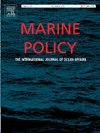Deciphering global marine product trade dynamics: Patterns, drivers, and policy insights
IF 3.5
2区 社会学
Q2 ENVIRONMENTAL STUDIES
引用次数: 0
Abstract
Challenges like near shore fisheries depletion, constrained capacity in offshore environments, and high sea fishing costs underscore marine product trade’s pivotal role for countries balancing their market. As the continuous expansion of the global marine product trade, corresponding trade networks are becoming increasingly complex. An in-depth analysis of its intricate trade network becomes crucial. To this end, this paper utilizes global trade data during 2000–2022 to construct a weighted directed complex network, employing complex network analysis to examine its spatiotemporal evolution. Additionally, a geographically weighted regression model is employed to systematically analyze the factors influencing the global marine product trade network, and uncover its internal evolutionary mechanisms. The results indicate: 1) the number of nations engaged in global marine product trade has steadily increased, with import ones often outpacing export ones, signifying a seller-dominated market; 2) the trade partners for each nation have remained stable, but there has been a notable increase in export partners since 2015; 3) the USA, Spain, and Thailand maintain their leadership, with Japan diminishing and China rapidly ascending; 4) the influence of per capita GDP and population size is shaped by global economic stability and major events; 5) economic and population factors affect marine product trade with notable regional and temporal variation. These findings may help nations in crafting reasoned marine product trade policies, fostering international cooperation and sustainable development in marine fisheries.
解读全球海产品贸易动态:模式、驱动因素和政策见解
近岸渔业枯竭、近海环境能力受限以及海上捕捞成本高等挑战凸显了海产品贸易对各国平衡其市场的关键作用。随着全球海产品贸易的不断扩大,相应的贸易网络也日趋复杂。对其错综复杂的贸易网络进行深入分析变得至关重要。为此,本文利用2000-2022年全球贸易数据构建了一个加权有向复杂网络,并运用复杂网络分析对其时空演化进行考察。此外,采用地理加权回归模型系统分析了全球海产品贸易网络的影响因素,揭示了其内部演化机制。研究结果表明:1)参与全球海产品贸易的国家数量稳步增加,进口海产品的数量往往超过出口海产品的数量,表明市场以卖方为主导;(2)各国贸易伙伴国保持稳定,但出口伙伴国自2015年以来有明显增长;3)美国、西班牙和泰国保持领导地位,日本衰落,中国迅速崛起;人均GDP和人口规模的影响受全球经济稳定和重大事件的影响;5)经济和人口因素对海产品贸易的影响具有显著的区域和时间差异。这些发现可能有助于各国制定合理的海洋产品贸易政策,促进海洋渔业的国际合作和可持续发展。
本文章由计算机程序翻译,如有差异,请以英文原文为准。
求助全文
约1分钟内获得全文
求助全文
来源期刊

Marine Policy
Multiple-
CiteScore
7.60
自引率
13.20%
发文量
428
期刊介绍:
Marine Policy is the leading journal of ocean policy studies. It offers researchers, analysts and policy makers a unique combination of analyses in the principal social science disciplines relevant to the formulation of marine policy. Major articles are contributed by specialists in marine affairs, including marine economists and marine resource managers, political scientists, marine scientists, international lawyers, geographers and anthropologists. Drawing on their expertise and research, the journal covers: international, regional and national marine policies; institutional arrangements for the management and regulation of marine activities, including fisheries and shipping; conflict resolution; marine pollution and environment; conservation and use of marine resources. Regular features of Marine Policy include research reports, conference reports and reports on current developments to keep readers up-to-date with the latest developments and research in ocean affairs.
 求助内容:
求助内容: 应助结果提醒方式:
应助结果提醒方式:


